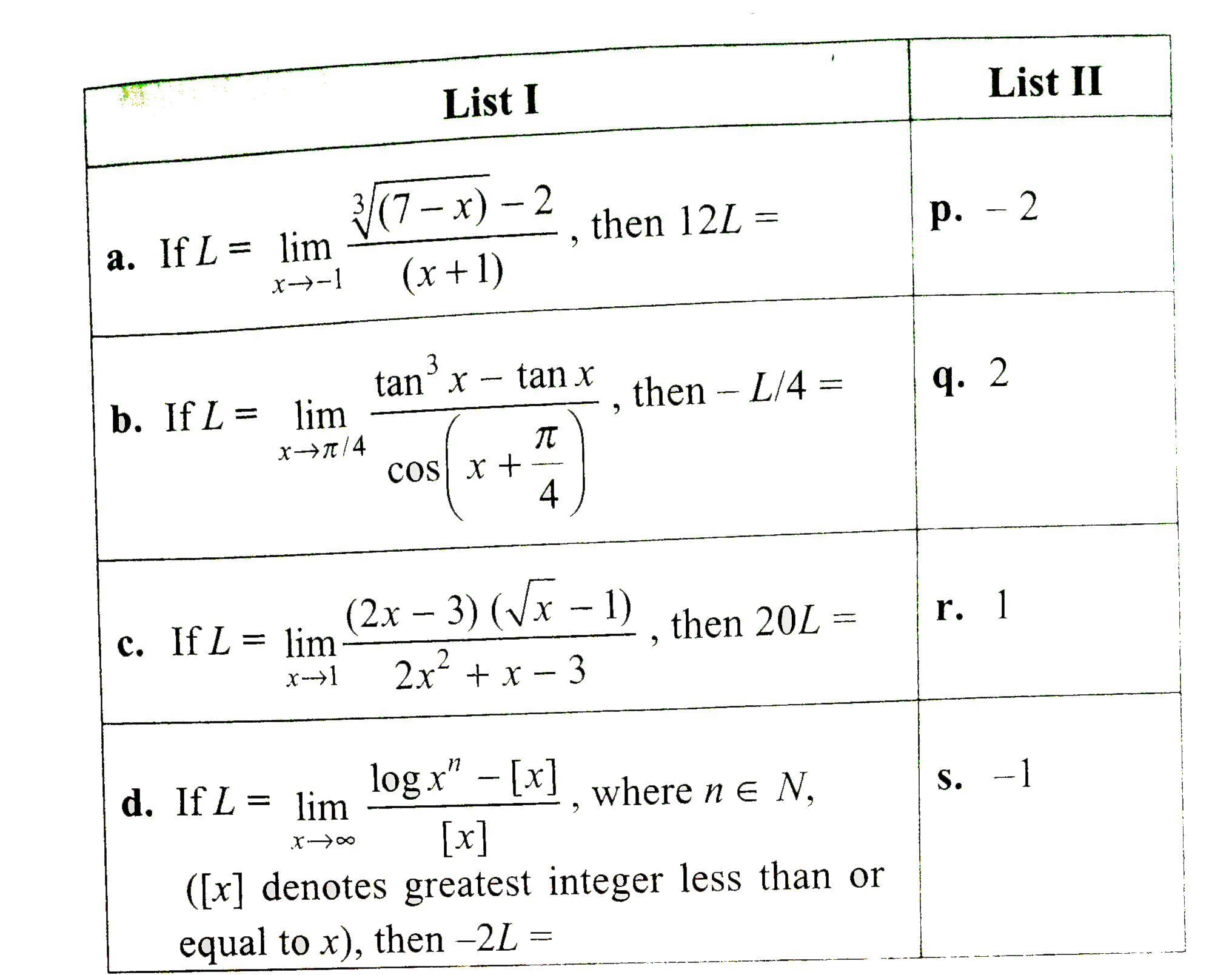L=(lim)x→a|2sinx−1|2sinx−1.Then limit does not exist when a=π6 L=−1whena=π L=1whena=π2 L=1whena=0Solution in Tamil
1/2
−1/3
−1/6
3
The correct Answer is:A, B, C
L=limx→a|2sinx−1|2sinx−1
For a=π/6.
L.H.L.=limx→π−61−2sinx2sinx−1=−1
R.H.L.=limx→π+62sinx−12sinx−1=1
Hence, the limit does not exist.
For a=π,limx→π1−2sinx2sinx−1=−1 (as in neighborhood of π,sinx is less than 12).
For a=π2,limx→π/22sinx−12sinx−1=1 (as in neighborhood of π2,sinx approaches 1).
Topper's Solved these Questions
- BOOK - CENGAGECHAPTER - LIMITSEXERCISE - Exercise (Comprehension)20videos
LIMITS
- BOOK - CENGAGECHAPTER - LIMITSEXERCISE - Exercise (Matrix)5videos
LIMITS
- BOOK - CENGAGECHAPTER - LIMITSEXERCISE - Exercise (Single)76videos
LIMITS
- BOOK - CENGAGECHAPTER - JEE 2019EXERCISE - Chapter 109videos
JEE 2019
- BOOK - CENGAGECHAPTER - LINEAR COMBINATION OF VECTORS, DEPENDENT AND INDEPENDENT VECTORSEXERCISE - DPP 1.210videos
LINEAR COMBINATION OF VECTORS, DEPENDENT AND INDEPENDENT VECTORS
Similar Questions
Find the domain of f(x)=√|x|−{x} (where {⋅} denots the fractional part of x).
04:32View SolutionMatch the following lists:
 05:02View Solution
05:02View Solution(lim)x→0[sin(sgn(x))(sgn(x))], where[.] denotes the greatest integer function, is equal to (a)0 (b) 1 (c) −1 (d) does not exist
01:47View SolutionIf y = y(x) is the solution of the differential equation, xdydx+2y=x2 satisfying y(1) = 1, then y(12) is equal to
01:31View SolutionThe number of integral values of p for which (p+1)ˆi−3ˆj+pˆk,pˆi+(p+1)ˆj−3ˆk and −3ˆi+pˆj+(p+1)ˆk are linearly dependent vectors is q
01:52View SolutionIf x+y=π4andtanx+tany=1,then(n∈Z) (a)sinx=0always (b)when x=nπ+π4theny=−nπ (c)when x=nπtheny=nπ+(π4) (d)when x=nπ+π4theny=nπ−(π4)
05:00View SolutionL=(lim)x→a|2sinx−1|2sinx−1.Then limit does not exist when (a) a=π6 (b) L=−1whena=π (c) L=1whena=π2 (d) L=1whena=0
01:01View SolutionIf L=+(lim)x→1(2x−3)(√x−1)2x2+x−3, then 20 L=
04:37View SolutionIf L=(lim)x→∞logxn−[x][x], where n∈N, then−2L=
07:15View SolutionFind the volume in cubic metre (cu. m) of each of the cuboids whose dimensions are: length = 12m, breadth=10m, height=4.5m
04:23View Solutionint_ (0)^(4 pi) e^(t) (sin^(6) at+cos^(4) at) dtint_ (0)^(pi) e^(t) (sin^(6) at+ cos^(4) at) dta = 2, L = (e^(4 pi) -1)/(e^(pi) -1) (ii) a = 2, L = (e^(4 pi)+ 1)/(e^(pi) +1) (iii) a = 4, L = (e^(4 pi) -1)/(e^(pi) -1) (iv) a = 4, L = (e^(4 pi) +1)/(e^(pi) +1)
01:49View Solutionf(x)=[(sinx)/x ,"w h e n"x!=0=2,"w h e n"x=0 sinx-, when x0/(x) =L= 2, when x=0
04:06View Solutionयदि l1=ddx(esinx)
l2=limh→0esin(x+h)−esinxh
l3=∫esinxcosxdx
है तो निम्न में से कोन-सा सही है?02:06View SolutionIf x+y=π4andtanx+tany=1,then(n∈Z) (a)sinx=0always (b)when x=nπ+π4theny=−nπ (c)when x=nπtheny=nπ+(π4) (d)when x=nπ+π4theny=nπ−(π4)
02:55View SolutionL=(lim)x→a|2sinx−1|2sinx−1.Then limit does not exist when (a) a=π6 (b) L=−1whena=π (c) L=1whena=π2 (d) L=1whena=0
02:13View SolutionStatement 1: For a singular square matrix A,AB=ACB=C. Statement 2; |A|=0,thenA−1 does not exist.
03:16View Solution

